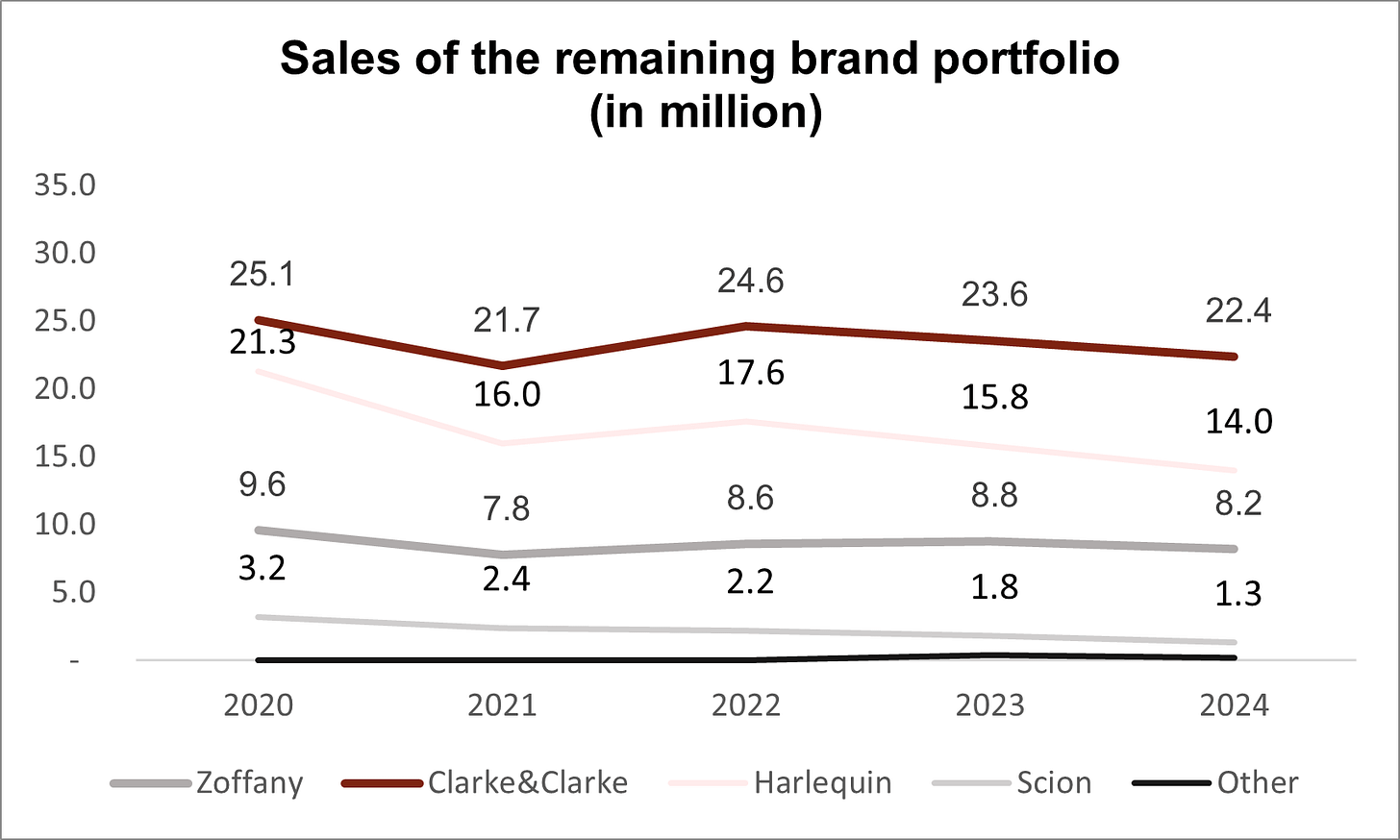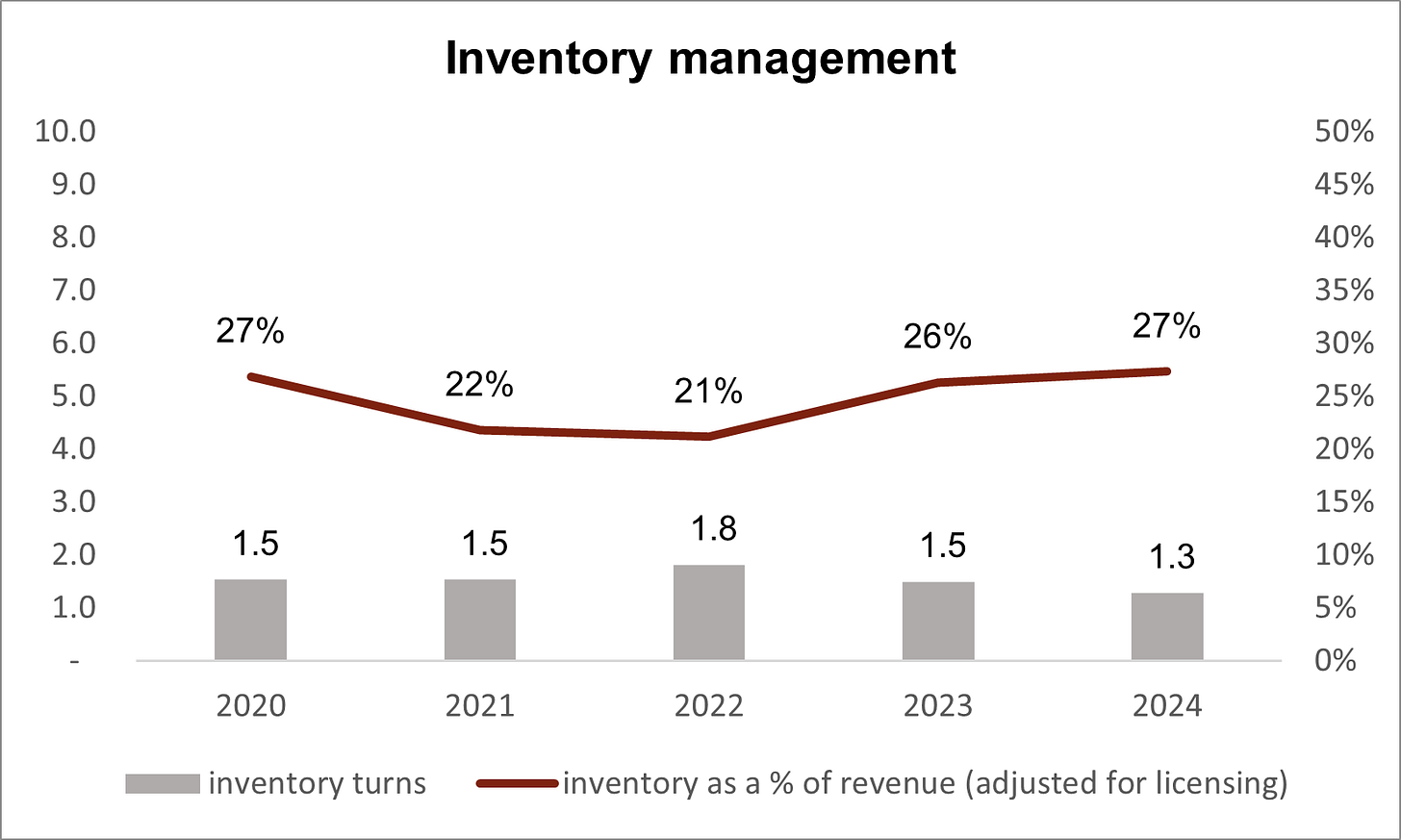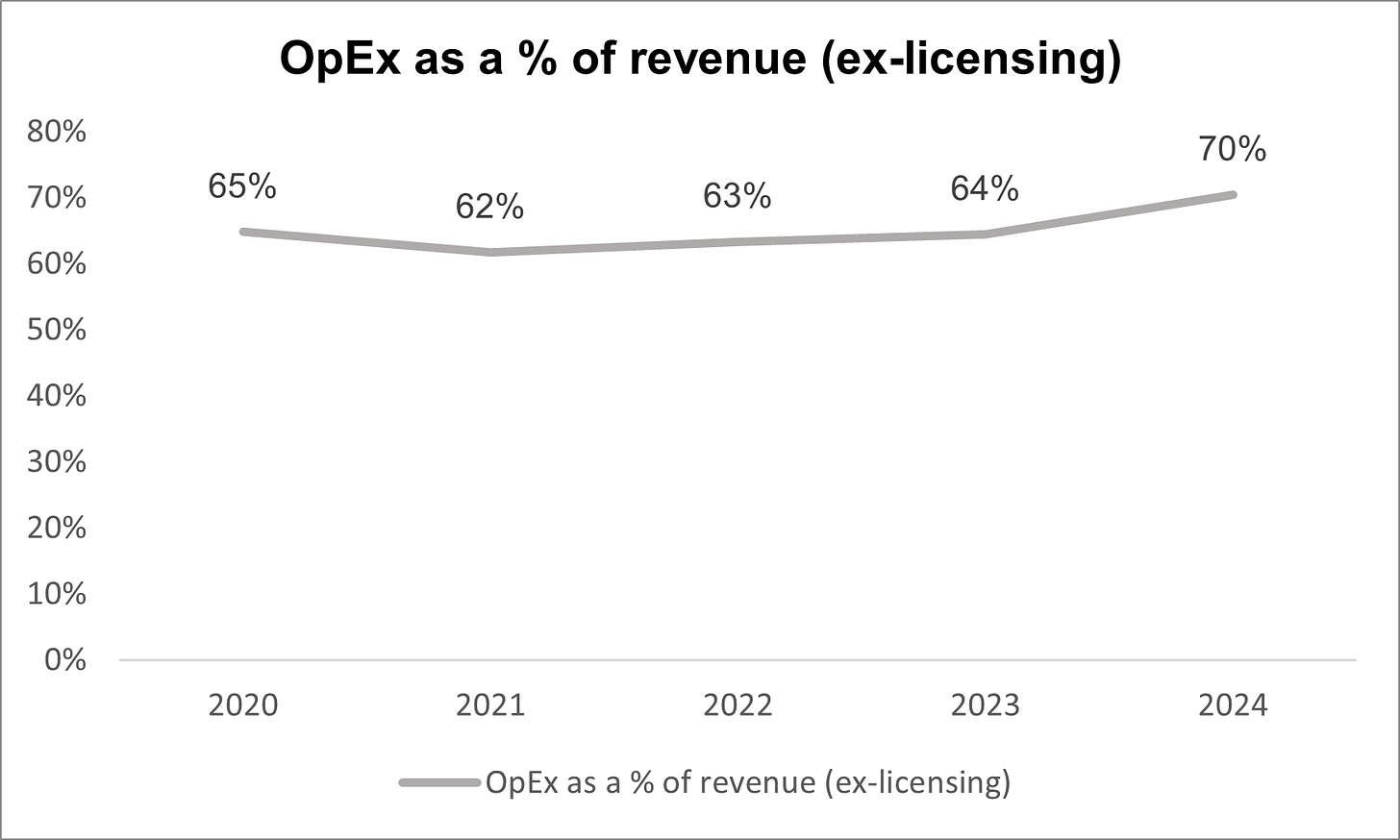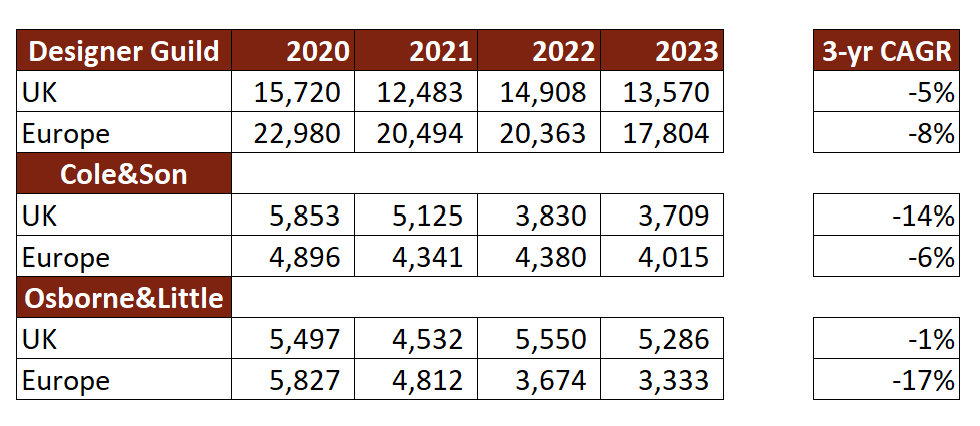For the past two years, I’ve shared company analyses only on the stocks I own. The blog's readership has grown significantly since then, so I've decided to write at a more consistent pace.
As a result, I will now be sharing my thoughts on micro-caps on my watchlist as well. The ones that have something unique about them. And IMO are worth adding to a watchlist and closely following. So, when the time is ripe, you can pull the trigger without having to spend weeks on initial due diligence.
I expect these write-ups to be less extensive than the ones I usually share, but probably less biased. After all, it's not that easy to be super negative on the stock you own.
The first MikroKap Watchlist idea I’d like to share with you is Sanderson Design Group.
I've been following this one since it was above 100p. And with the price plummeting below 60p following the earnings announcement last week, I thought the risk-reward was compelling enough for a write-up.
$SDG.L
SDG is a luxury interior furnishings company that produces, designs, and sells premium wallpapers and fabrics.
The first thing that draws me to this business is their IP. SDG owns an archive of 75 000 designs and samples dating all the way back to the 18th century. They own six luxury and premium British brands, the strongest of which are Morris & Co. and Sanderson.
Sanderson was established in 1860 and is currently the oldest existing English brand in the home furnishing sector. It is considered iconic in the UK and has held a Royal Warrant for over a century. To put it simply, since 1923, Sanderson has been supplying their fabrics and wallcoverings to the Royal Residencies, and hence the British royal family.
SDG is permitted to market the Royal Warrant status under its trademark, which IMO provides a durable competitive advantage.
If the image is too small for you to read, the caption says: “By appointment to HM Queen Elizabeth II Suppliers of Wallpapers, Paints and Fabrics. Arthur Sanderson and Sons of England”
Another strong brand in the portfolio is Morris&Co. It was likewise founded in the 19th century, just a year later, and is even more well known than Sanderson. I believe most of you are familiar with William Morris, the brand’s founder. However, for those of you who are as ignorant as I am and are more into finance, I’ll break it down. He was a significant art figure of the 19th century, and supposedly “anyone who studies art knows Morris.”
Morris is regarded as the father of interior design, thus, this brand is naturally SDG’s primary focus.
Sanderson and Morris accounted for more than 40% of SDG’s total brand sales in H1 2025 and have proven to be their most durable and recession-proof due to their perception of luxury heritage. Going forward, I expect SDG’s top two brands will continue to outgrow the overall portfolio. This will inevitably result in less diversification for the business but a higher gross margin profile.
The remaining four brands in the portfolio may not warrant (pun intended) as much pricing power as the first two, but they are likewise durable and have, over time, carved out a niche of their own.
Zoffany, the group’s oldest brand, dates back to the 17th century and occupies the highest price point in SDG’s range. Its heritage is best recognized in the US; however, previous industry downturns have shown it to be less recession-resistant than Sanderson or Morris.
Clarke & Clarke is SDG’s largest brand in terms of sales, falling more into the (accessible) premium segment than luxury.
Aside from C&C, SDG owns two other non-heritage brands; Harlequin is the best-selling fabric/wallpaper brand in John Lewis, while Scion is the youngest SDG’s brand, primarily used for licensing. Based on my research, I concluded that these two brands are not that well-established and are the only ones in the portfolio that face some “fashion” risk. Clarke & Clarke, on the other hand, while modern, has proven to be stable and resilient since SDG purchased it in 2016.
To better monetize this IP, SDG has been on a mission of digitalizing their vast archive. That process was completed just last month, and the company can now easily catalogue its designs, decide what to do with them, and better commercialize those that have been collecting dust all these centuries.
One way to use its brand IP is selling through dedicated DTC websites. SDG did this with Sanderson in 2021 and with Morris just last month.
The second and better example of leveraging IP is SDG’s licensing segment. Which is also one of the main reasons why I find this setup investable.
License and registration, please.
Since the new management took over in 2019, SDG has made a significant push into licensing. That strategy makes sense to me as this is an asset-light business that can operate with a close to 100% margin profile while taking virtually no risk.
This is how it works: SDG licenses its own designs to clients, who then use them on a variety of products, including bed and bath collections, rugs, blinds, tableware, and apparel. The license agreements commonly include the minimum guarantee but also allow SDG to participate in the upside through a royalty that is linked to the amount of revenue generated from licensees’ products. The only thing SDG needs to provide to the licensee is the expertise of its design team to “transfer” the design from fabric to a different product or a different material.
The only hurdle to success is your team’s ability to sell, and the only risk you’re facing is that you overdo it and dilute your brands. While also allowing you to market your products through different channels than usual, at no extra cost.
SDG initially signed shorter-term partnerships with clients who used the license for a narrow range of products. The management team has gotten creative since and is now signing multi-year deals for “unexpected” product lines, such as the agreement with Ruggable, a washable rug company.
SDG’s customers include large corporations such as Disney, Zara, John Lewis, NEXT, Sainsbury, and Williams Sonoma. And a renewal rate of more than 90% shows that these companies are not just experimenting but intend to do work with SDG and its IP in the long run.
SDG has generated 3.2M in core licensing revenue (adjusted for accelerated income and one-time apparel collaborations) in H1 2025 and 6.2M during the last fiscal year. With more contracts in the backlog for the second half, core licensing revenues doubling over the last 5 years, and it being a 100% gross margin stream, I believe paying at least 15x multiple for SDG’s annual license income is not unreasonable.
The licensing segment now accounts for less than 10% of SDG’s total revenue, while a 15x multiple would cover SDG’s current market cap of 48M by two times.
Of course, I don’t consider SOTP as the right approach to the value of SDG or the rest of the business without problems. I’m just giving you some food for thought.
So more on that later; for the time being, let’s focus on the second lever that makes this business and opportunity intriguing.
USA, USA
SDG does not sell its fabrics and wallpapers directly in the US, in the UK, or in Europe, with the former market structured very differently. Outside of the United States, SDG acts as a de facto wholesaler, selling its fabrics through a large network of 6,000 retail customers.
In contrast, business in the US is done through interior designers, who are intermediaries who own their own studios and handpick designs for their high-net-worth clients.
This type of structure allows for higher margins than physical retail and less competition. This “agency model” is best explained in the following paragraph from the book Capital Returns.
Unlike the previous management team, the current leadership has made the US its sole focus. They have opened a dozen showrooms as well as two offices in New York and Chicago.
Management believes that, although smaller, their competitors are more well-known in the US than SDG. This is not the case in the UK, so increasing brand awareness in the United States remains SDG’s top focus.
While digging through the data of their public and private competitors, I found this claim to be true, with most of SDG’s competitors doing about 50–70% of their business in the US. While SDG’s US business currently amounts to less than one third of overall brand sales. So I’m glad a new SVP of Sales was just hired to further penetrate into this market and bring that percentage up.
The evident growth of US business can be observed here.
Further growth in licensing and the US as a percentage of revenue are two elements that should make SDG’s growth more appealing than the LSD% attained historically, while also enhancing gross margins.
Another aspect that should benefit margins in the future, but in a different way, is a shift to:
Digital manufacturing
In addition to their brand and licensing business, SDG is also a manufacturer of its fabrics and wallpapers. Standfast is the name of their textile mill, while Anstey is the name of their wallpaper factory. This vertical integration benefits SDG because it allows for better quality controls when producing own products, as well as lots of design testing “until its right.”
On the other hand, in-house manufacturing is a complex, inventory heavy business that requires significant capex to operate. This makes the fixed costs high, the business more asset-heavy, and margins more volatile.
As a result, most of SDG’s competitors chose to outsource manufacturing, leaving SDG as one of the very few companies in the UK with in-house manufacturing capabilities. They not only manufacture their own products but also for both UK and overseas clients. Many of these clients are also SDG’s competitors.
Designs in Standfast, the fabrics plant, are highly regarded in the industry for its skilled design specialists, while Anstey is the home to the UK’s largest wallcovering printer, renowned for its various printing techniques.
Although this business has unattractive economics, I think it fits well into the design-led strategy, which it has been pursuing all these years.
This segment also stood the test of time as well as others have, with Standfast celebrating its 100th anniversary this year and Anstey being more than 50 years old.
However, I am quite torn about what to think about the future of this segment.
On the one hand, there are options for improving both manufacturing and investors’ perception of it. For example, eight years ago, SDG began its digital journey. This process was further accelerated under the new management, and digital printing revenue currently accounts for more than 50% of SDG’s total output.
The advantage of digital over traditional printing techniques is that allows for better forecasting and less physical sampling, which are the highest costs for these types of textile companies.
Here’s a quote from two of Lisa’s interviews explaining what makes digital more efficient:
“We print a minimum order of, say, 300 yards, we chop up the first 200 to put them in pattern books. But somebody then takes around the country in the back of their car, hoping somebody will buy it or like it. And really, it can’t be the solution, can it. And then, God forbid, you get an order for 101 yards, and you’ve only got 100 left. You know, you find yourself printing another 300.” ~Lisa Montague @ BoH podcast
Or why more digitization means you can lower the minimum quantities required to manufacture "in one go," allowing for additional testing and design options.
Show host:
“But that’s one of the great things about digital as well, it unlocks volume. You can take much smaller meterage because you’re not scaling, you don’t have to do mass production. So, you can actually trial 25 meters, 30 meters, put it together and play with it. In the past you could only go, if you’re manufacturing them, you’re manufacturing thousands of meters.”
Lisa Montague (Sanderson CEO) replying:
“Standfast may not go down to 25 meters yet, but you know, it has come down from 300 to, say, 100, in quiet short time.”
Furthermore, marketing their samples digitally helped SDG collect feedback faster and better identify the most popular designs and colorways among their portfolio. This approach eliminates unnecessary inventory that would come with physical samplers / catalogues and allows SDG to focus on fewer and larger collection launches rather than many.
For example, the Sanderson brand currently only does one launch per year, and the management states that they won’t do any launches unless they bring additional value and that they will use conventional processes “only if critical.”
Since taking over, they have indeed focused on reducing SKUs and launching narrower collections with attractive SKU ROI. This can be noticed in the chart below, which Lisa refers to as “her favorite chart.”
On the other hand, although all these benefits of digital printing sound fine and dandy on paper, I’ve still got a problem with them:
They don’t translate to better financials!
I used inventory as % of revenue (excluding licensing) to evaluate the efficiency of their WC management and results of digital manufacturing.
Although fiscal 2021 and 2022 numbers may have led investors to believe that digital manufacturing is the greatest thing since sliced bread, the trend reversed in the following years.
The bulls could argue that higher than optimal inventory levels in 2023/24 are not because digital manufacturing doesn’t help, but due to the industry’s current downturn, which includes unexpectedly low sales levels and therefore lower factory output. Whereas the bears may argue that the only reason why inventory was relatively lower in the 2021-2022 period was because consumers were temporarily restocking following COVID and that SDG benefited from de-globalization and more customers opting to do business with UK factories rather than Asian ones.
The verdict on digital manufacturing is still out, and I’ll have yet to reach a firm conclusion. Divesting manufacturing would be bullish for the capital structure and SDG’s valuation on the market. However, transitioning to print-to-order, as management intends, would likely be even more bullish in the long run, while also maintaining control over the manufacturing process.
A two-sentence thesis summary would be that SDG is capitalizing on the tailwinds of the US market while also monetizing their design catalog through a high-margin licensing stream. Both growth drivers will cause operating leverage for the business, with even higher margin potential if the transition to digital manufacturing ends up bringing additional efficiencies.
So assuming a ~3.5% median FCF margin (excluding lease payments and licensing) in the future for the SDG. Something that this company has been able to achieve over the previous 20 years, despite both industry ups and downs. And with much significantly lower penetration in the US and no reliance on digital manufacturing. That gets us to at least 3M in FCF (leases excluded) on the current revenue base excluding licensing, and 6.4M in FCF coming from licensing income. So close to 10M in normalized FCF compared to the current EV of 50M (leases included). That is very cheap, if you ask me, for an owner of these heritage brands.
The downside is also protected by a valuation of 0.8x P/TBV, with tangible book consisting of valuable Standfast, Anstey PP&E, and current assets including a substantial cash position and 5-year life-cycle inventory.
So why am I not long the stock, you might ask?
My main worries with this setup stem from the…
Management
Lisa Montague left one of LVMH’s luxury Maisons, Loewe, and took the CEO role in April of 2019. She brought Mike Woodcock as her new CFO, two years later.
While I think Lisa is lovely and Mike is a rational man, I don’t particularly like their track record at the helm of SDG. Especially when combined with the lack of insider ownership.
On the one hand, I believe they are pursuing the “right strategy” by expanding into the US , like their decentralized approach to brand management, and like that they are “giving heritage brands a new life” through licensing. On the other hand, I think the capital allocation is suboptimal, communication with shareholders needs improvement, and I am concerned that they aren’t exactly long-term thinkers.
Let me explain.
Regarding capital allocation, I worry about heavy investments in the “Live Beautiful” ESG strategy, which is primarily geared at achieving net carbon zero by 2030. Capex has increased since Lisa took control and will continue to rise in the future. She believes that any additional capex needs to be closely aligned with this Live Beautiful strategy. Although I understand that by being "sustainable,” you can attract customers you might not have otherwise and probably bring you a better reputation within the industry, I’m concerned that this might translate into poor ROIC and even shareholder value destruction. This seemed particularly troubling when I discovered that around a third of their annual bonus is tied to these ESG initiatives.
Aside from the uncertainty about returns on their future capex, I don’t like the lack of buybacks at this valuation, and I particularly dislike the fact that they lowered the dividend by 33% just last week. Conditions in the industry may be tough, but I believe there was no need for this move because the payout ratio in prior years was already low, at approximately 30%, and SDG has a strong balance sheet with 10M in net cash that can easily weather the storm.
What I’d want to see from them is more opportunistic capital allocation rather than a reactive approach.
Regarding my poor communication with shareholders comment, I can just say that none of my e-mails were responded to and that during the most recent earnings call, a few other investors and I submitted some questions online. On the call, they picked two of the “easiest” questions to answer and ignored the others, claiming that “there are no further questions.”
Regarding the absence of a long-term thinking point, I believe this is apparent if you have been following SDG’s press releases over the past year.
Each of these large, red candles that you can notice on the chart was caused by their posting of a trading update, or, what I like to call, a “trading update of a trading update.”
I believe this flip-flopping with trading updates serves no purpose and that it would be prudent if the management stopped providing us with updated outlook/expectations every other month and instead updated us on how they executed semiannually. After all, you get the shareholder base you cater to, and they appear to be pandering to the short-term ones.
Furthermore, I believe that if someone followed the same plan as the current management, they would be able to execute it more quickly.
Or better?
That leaves me to my last point.
The current state of SDG
The home furnishing industry is closely linked to (high-end) housing activity. And although there was a temporary surge in house-related spending during the pandemic, higher interest rates in recent years have damped the demand for SDG’s products.
High EU import duties and extra layers of documentation post Brexit, as well as a 1.8M sales loss due to Russia exit, didn’t help either.
However, weak consumer and industry downturns in the past did not equal a negative FCF for SDG’s business.
Due to the inventory-heavy nature of the business, SDG has countercyclical cashflows and has managed to remain profitable even throughout GFC.
However, if you dig beneath the hood and adjust profitability for core licensing income, you’ll notice that the remaining business, which accounts for close to 100M in revenue, has been FCF negative for four of the last 5 years.
Furthermore, if you look at the overall revenue growth since Lisa took over and exclude the licensing segment, you’ll find that the business has shrunk. And you’ll also notice that the brand segment excluding the US market was also declining throughout the same period.
I find this particularly concerning given that most of the management’s explanations for declining revenue were “difficult marketplace,” “challenging consumer environment,” or “challenging trading conditions.” Refusing to take responsibility for any unsatisfactory performance.
I believe that the weak UK and Europe markets really are partially responsible for the reduction in core business; however, I think a portion of it is due to current management’s team's lack of focus on this historic backbone of SDG’s business.
This is evident when look at the disparity between high gross margin, which indicates good pricing power, as well as durability of brands and EBIT margin, which takes into account operational performance. Even licensing-excluded and despite difficult trading conditions, gross margins have continued to expand in recent years. However, you can clearly notice EBIT margins suffering despite management’s constant efforts to “keep the costs tight”.
To determine whether there is some kind of structural problem with management’s approach to UK and European markets, I compared SDG’s performance to that of industry peers over the last few years.
The industry
Before I begin this comparison, keep in mind that SDG is the largest player in the UK upper market, with in-house manufacturing, mostly competing with smaller asset-lighted companies. So this won’t be exactly apples-to-apples.
Maybe the most equivalent in terms of size and brand positioning is Colefax, which is the only other publicly traded competitor.
The graph above shows a substantially worse performance for SDG compared to CFX within their historic markets. SDG compounded UK revenues at a negative 4% CAGR and Norther Europe revenues at a negative 6.5% CAGR, while Colefax saw a 7.8% CAGR in the UK and a 8.6% CAGR in Europe during the same period. In the first part of fiscal 2025, both companies saw declines in the UK, in the range of 12%, and a 2-3% decline in Europe.
Naturally, after seeing the data, I assumed that there must be some sort of structural issue going on within SDG’s core markets. However, one peer is never enough to arrive at a conclusion, so I dig further.
Unfortunately, most of these companies are either privately held or US-headquartered; therefore, they aren’t required to publicly file their financials, or they were granted an exemption to file for gov.uk.
The only data available is for these three privately held competitors.
These appear to be even worse than SDG numbers, despite the fact that they have yet to disclose numbers for fiscal 2024 or H1 2025, which were the most difficult years for the industry following the pandemic.
Thus, although without a firm conclusion, I still believe that adverse market conditions are industry-wide and that SDG’s problems in their historic markets are more cyclical than of structural nature. This also highlights Colefax’s unique ability to weather these storms. (I’ll also write about Colefax at some point.)
This brings an end to this analysis. The only thing left to outline is how I see the risk reward from here.
Scenarios
Bear case
SDG business adjusted for licensing fails to be profitable in the long run, so growth in licensing and in the US market merely help to keep the business afloat. Management’s reinvestment plans hurt current shareholders.
In this case, SDG represents a below-average opportunity, possibly even a value trap. However, further growth in the US and through licensing, as well as increased reliance on Sanderson and Morris&Co brands, should keep the downside protected.
Base case
You’re buying SDG stock precisely when you need to be buying it. At the bottom of a cycle, below tangible book value and after 2.5 years of negative revenue growth for their main business.
The market’s very negative sentiment is abundantly clear if you read the comments from UK retail investors on stock portals or if you just glance at analyst estimates.
For example, Progressive research, which IMO provides the best coverage of SDG of the few brokers that do, is clearly extrapolating permanently negative/muted environment for the business.
After SDG’s results didn’t meet their expectations for 2022 and 2023, Progressive now projects 2026 EBITDA to be 20% lower than was in 2022 and 2026 EPS to be nearly 40% lower than in FY2022.
And while a recession or a further slowdown in the housing market would make these estimates reasonable, I believe there’s more room for SDG to surprise on the upside than is for the sentiment to further deteriorate.
Even if you don’t give credit to US or digital manufacturing initiatives and think that the remaining business will only be able to operate at FCF (after lease payments) breakeven in the future. The stock is still too cheap, with more than 6M in annual licensing income, a 48 million market cap and a 10M net cash position (excluding leases).
Bull case
BoE rate cuts lead to cycle recovery, and management succeeds in its cost-cutting initiatives in the UK and Europe. At the same time, the US market drives the FCF margins (after lease payments) to a 3-5% range over the longer term. Where in the range? It depends on the success of digital manufacturing.
As a result, by adding in the licensing segment, you’re getting a cycle average FCF yield of 24-29%, on the current revenue base, which should grow in the future.
PE optionality
SDG's low debt, minimal insider ownership, and potential of licensing make it an attractive candidate for an LBO takeover by private equity.
All in all, I find $SDG.L intriguing right now due to its durable brands and underappreciated push into the US and licensing. Although beaten down, the risk-reward is not there for me yet. Especially when compared to my current portfolio. Nonetheless, it's something to keep an eye on!
Feel free to share any suggestions on improving this “MikroKap Watchlist” concept.
And if you wish to support this kind of work, consider becoming a free or paid subscriber.
The Mikro Kap uses information sources believed to be reliable, but their accuracy cannot be guaranteed. The information contained in this publication is not intended to constitute individual investment advice and is not designed to meet your personal financial situation. The opinions expressed in such publications are those of the publisher and are subject to change without notice. You are advised to discuss your investment options with your financial advisers.
Consult your financial adviser to understand whether any investment is suitable for your specific needs. I may, from time to time, have positions in the securities covered in the articles on this website. This is not a recommendation to buy or sell stocks. Due your own due diligence. The author reserves the right to buy or sell any securities mentioned in this article at any time, without prior notice.
































Great write up!
I certainly share your view on managements and incentives.
But as a result I think they are a prime take over candidate.
Balance sheet certainy gives a margin of safety.
Defintely adding to my watch list!
Sdg at a deep discount now but a grubby story. Probably a good buying point. Cfx the better managed and run business and greater growth momentum now. Also probably very cheap. I'd buy both here